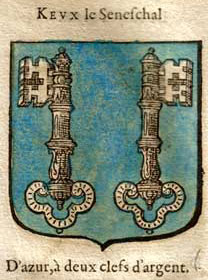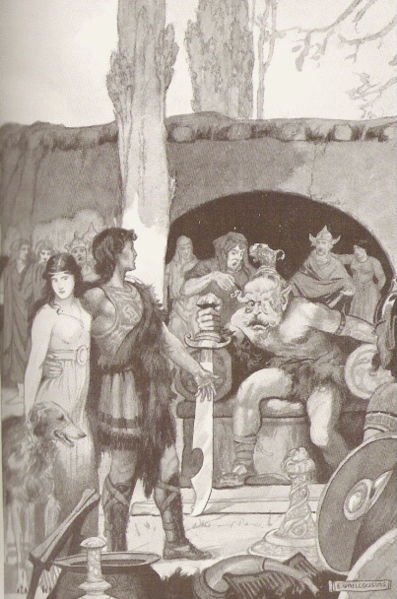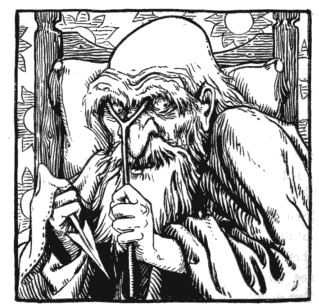|
Sir Kay
In Arthurian legend, Kay (, Middle Welsh ''Kei'' or ''Cei''; ; French: ''Keu''; Old French: ''Kès'' or ''Kex'') is King Arthur's foster brother and later seneschal, as well as one of the first Knights of the Round Table. In later literature he is known for his acid tongue and bullying, boorish behaviour, but in earlier accounts he was one of Arthur's premier warriors. Along with Bedivere, with whom he is frequently associated, Kay is one of the earliest characters associated with Arthur. Kay's father is called Sir Ector, Ector in later literature, but the Welsh accounts name him as Cynyr Ceinfarfog. Cai in Welsh tradition Cai or Cei is one of the earliest characters to be associated with the Arthurian mythology, appearing in a number of early Welsh texts, including ''Culhwch and Olwen, Culhwch ac Olwen'', ''Three Welsh Romances, Geraint fab Erbin'', ''Three Welsh Romances, Iarlles y Ffynnon'', ''Peredur fab Efrawg'', ''Breuddwyd Rhonabwy'', ''Pa gur, Pa Gur'', and the Welsh Tr ... [...More Info...] [...Related Items...] OR: [Wikipedia] [Google] [Baidu] |
Welsh Triads
The Welsh Triads (, "Triads of the Island of Britain") are a group of related texts in medieval manuscripts which preserve fragments of Welsh folklore, mythology and traditional history in groups of three. The triad is a rhetorical form whereby objects are grouped together in threes, with a heading indicating the point of likeness; for example, "Three things not easily restrained, the flow of a torrent, the flight of an arrow, and the tongue of a fool." Contents The texts include references to King Arthur and other semi-historical characters from sub-Roman Britain, mythic figures such as Brân the Blessed, undeniably historical personages such as Alan IV, Duke of Brittany (who is called ''Alan Fyrgan'') and Iron Age characters such as Caswallawn ( Cassivellaunus) and Caradoc ( Caratacus). Some triads simply give a list of three characters with something in common (such as "the three frivolous bards of the island of Britain") while others include substantial narrative explanation ... [...More Info...] [...Related Items...] OR: [Wikipedia] [Google] [Baidu] |
Menw
Menw, son of Three-Cries (), is a hero and shapeshifter in early Welsh literature, an "Enchanted Knight" of King Arthur at his court at Celliwig. He appears most prominently in the early Arthurian tale ''Culhwch and Olwen'', in which he is handpicked among Arthur's warriors to accompany Culhwch on his quest to win Olwen. An "Enchanter Knight" of Arthur's court, he learned one of the Three Enchantments from Uther Pendragon. He is ascribed a son named Anynnawg. Role in Welsh tradition After being cursed by his stepmother so that he marry no one but Olwen, daughter of the giant Ysbaddaden, Culhwch ap Cilydd seeks assistance from his cousin Arthur to win her hand in marriage. Arthur agrees to help him, sending six of his many warriors to assist him on his quest, with Menw as the sixth. Each warrior has his own unique skill; Menw is a skilled magician, able to place he and his companions under an illusion of invisibility so as to protect them in savage lands. Prior to the Hunting of ... [...More Info...] [...Related Items...] OR: [Wikipedia] [Google] [Baidu] |
Goreu Fab Custennin
Goreu fab Custennin (also spelled as Gorau) is a hero of Welsh and early Arthurian mythology, the son of Custennin, and cousin to Arthur, Culhwch and Saint Illtud through their grandfather Amlawdd Wledig. He is a significant character in the Middle Welsh Arthurian tale ''Culhwch and Olwen'', and also appears in a number of other medieval texts. His name may be derived from ; "of Cornwall."Bromwich, Rachel. ''Trioedd Ynys Prydein.'' Role in Welsh tradition How Culhwch won Olwen While on the quest to locate the stronghold of Ysbaddaden Bencawr, Culhwch ap Cilydd and his six companions come across a shepherd and his flock. They learn that he is Ysbaddaden's brother, and that the giant has murdered twenty-three of his twenty four children. In a bid to save their youngest son from suffering the same fate, the shepherd and his wife hide him away in a chest. Cai, one of Arthur's foremost knights, offers to take the boy with him on the quest for Olwen, promising to fight to the d ... [...More Info...] [...Related Items...] OR: [Wikipedia] [Google] [Baidu] |
Celliwig
Celliwig, Kelliwic or Gelliwic is perhaps the earliest named location for the court of King Arthur. It may be translated as 'forest grove'. Literary references It is mentioned in the Welsh tale '' Culhwch and Olwen'' whose manuscript dates from the 11th century, though the story is much older. The story describes the court as being at Celliwig in Cernyw (the Welsh name for Cornwall), otherwise known as the kingdom of Dumnonia including modern Devon. The hall is guarded by Glewlwyd Gafaelfawr, Arthur's porter, and Culhwch has difficulty gaining entrance due to the special laws that restrict entry once a feast has begun. Though there is no description of the place the implications of the story are of great wealth and splendour. It describes Arthur's warriors at the court in depth and says that: "From here, one of his Warband, Drem, could see a gnat as far away as Scotland; while another, Medyr, could shoot an arrow through the legs of a wren in Ireland!" Some of the ''Trioedd Yn ... [...More Info...] [...Related Items...] OR: [Wikipedia] [Google] [Baidu] |
Olwen
In Welsh mythology, Olwen (or Olwyn) is the daughter of the giant Ysbaddaden and cousin of Goreu. She is the heroine of the story '' Culhwch and Olwen'' in the Mabinogion. Her father is fated to die if she ever marries, so when Culhwch (sometimes spelled as Kilhwch) comes to court her, he is given a series of immensely difficult tasks which he must complete before he can win her hand. With the help of his cousin King Arthur, Culhwch succeeds and the giant dies, allowing Olwen to marry her suitor. Description In the tale ''Culhwch and Olwen'' in the Mabinogion, she is described as a vision of beauty: wearing a flaming-red dress with a red-gold torc and many golden rings, she has "hair yellower than the broom", red (ruddy) cheeks, white skin and pale hands. She is also depicted as having the ability to spring white flowers from every step she takes. Other tales The name "Olwen" reappears in the non-Arthurian folktale ''Einion and Olwen'', about a sheep herder who travels to the ... [...More Info...] [...Related Items...] OR: [Wikipedia] [Google] [Baidu] |
Goleuddydd
Goleuddydd ("light of day" from the Welsh ''golau'', "light", and ''dydd'', "day"), in the Middle Welsh prose tale ''Culhwch ac Olwen Culhwch (, with the final consonant sounding like Scottish "loch"), in Welsh mythology, is the son of Cilydd, Cilydd son of Celyddon and Goleuddydd, a cousin of King Arthur, Arthur and the protagonist of the story ''Culhwch and Olwen'' (the earli ...'', is the daughter of Amlawdd Wledig, and is desired by Cilydd, who marries her. She becomes pregnant with his child, but becomes mad and turns to wandering the countryside. When she is near to giving birth, her senses return, and she takes shelter with a swineherd. Frightened by the pigs, she gives birth to a boy, apparently in a pig run. The swineherd takes the baby away to be baptised as Culhwch; he becomes the protagonist of ''Culhwch and Olwen''. Following the birth, Goleuddydd becomes fatally ill and, before dying, exhorts her husband not to remarry until he sees a briar with two blossoms on ... [...More Info...] [...Related Items...] OR: [Wikipedia] [Google] [Baidu] |
Cilydd
''Culhwch and Olwen'' () is a Welsh tale that survives in only two manuscripts about a hero connected with Arthur and his warriors: a complete version in the Red Book of Hergest, , and a fragmented version in the White Book of Rhydderch, . It is the longest of the surviving Welsh prose tales. Lady Charlotte Guest included this tale among those she collected under the title ''The Mabinogion''. Synopsis Culhwch's father, King Cilydd son of Celyddon, loses his wife Goleuddydd after a difficult childbirth. When he remarries, the young Culhwch rejects his stepmother's attempt to pair him with his new stepsister. Offended, the new queen puts a curse on him so that he can marry no one besides the beautiful Olwen, daughter of the giant Ysbaddaden Pencawr. Though he has never seen her, Culhwch becomes infatuated with her, but his father warns him that he will never find her without the aid of his famous cousin Arthur. The young man immediately sets off to seek his kinsman. He finds ... [...More Info...] [...Related Items...] OR: [Wikipedia] [Google] [Baidu] |
Culhwch
Culhwch (, with the final consonant sounding like Scottish "loch"), in Welsh mythology, is the son of Cilydd son of Celyddon and Goleuddydd, a cousin of Arthur and the protagonist of the story '' Culhwch and Olwen'' (the earliest of the medieval Welsh tales appended to Lady Charlotte Guest's edition of the Mabinogion). In this tale the etymology of ''Culhwch'' is explained as "sow run" (''cul'' "narrow, a narrow thing"; ''hwch'' "sow, pig"), but this is likely to be folk etymology. According to the narrative, Culhwch is born to his maddened mother Goleuddydd after she is frightened by a herd of swine. The swineherd finds Culhwch in the pigs' run, and takes him back to his father Cilydd. Culhwch is described as being "of gentle lineage". In ''Culhwch and Olwen'' Culhwch's father, King Cilydd son of Celyddon, loses his wife Goleuddydd after a difficult childbirth. When he remarries, the young Culhwch rejects his stepmother's attempt to pair him with his new stepsister. Offe ... [...More Info...] [...Related Items...] OR: [Wikipedia] [Google] [Baidu] |
Ysbaddaden
; "Ysbaddaden, Chief of Giants" (from roots meaning " hawthorn" or "infertile" - or perhaps implying both meanings), is the primary antagonist of the Welsh romance '' Culhwch and Olwen''.Helmut Birkhan: Kelten. Versuch einer Gesamtdarstellung ihrer Kultur. Verlag der Österreichischen Akademie der Wissenschaften, Wien 1997, , S. 473. A vicious giant residing in a nigh unreachable castle, he is the father of Olwen and uncle of Goreu fab Custennin. Culhwch's father, King Cilydd son of Celyddon, loses his wife Goleuddydd after a difficult childbirth. When Cilydd remarries after brutally murdering his new wife’s former husband, King Doged, the young Culhwch rejects his stepmother's attempt to pair him with his new stepsister. Offended, the new queen puts a curse on him so that he can marry no one besides the beautiful Olwen, daughter of the giant Ysbaddaden. Though he has never seen her, Culhwch becomes infatuated with her, but his father warns him that he will never find he ... [...More Info...] [...Related Items...] OR: [Wikipedia] [Google] [Baidu] |
Cath Palug
(also , , , literally 'Palug's Cat') was a monstrous cat in Welsh mythology associated with Arthurian legend. Given birth to in by the pig Henwen of Cornwall, the cat was to haunt the Isle of Anglesey until Kay went to the island to hunt it down. Outside of Wales, the cat's opponent has been transposed to King Arthur himself or, occasionally, other legendary heroes such as Ogier the Dane. Cath Palug's name in French literature is (Old French and variant modern forms: , ). Etymology The Welsh name may mean "scratching cat", but this is just one of a range of possible meanings. The word () is theorized to have a common stem, which may mean: 'hit, strike', 'cut, lop', 'scratch, claw', or even 'dig, pierce'. , the French form can be broken down into 'cat' + 'bog', hence 'the bog cat'. In an Anglo-Norman poem (see #Li Romanz des Franceis">§''Li Romanz des Franceis''), Chapalu and are connected in the story (the words are end-rhymed in the couplet). Aquatic nature Ca ... [...More Info...] [...Related Items...] OR: [Wikipedia] [Google] [Baidu] |
Nine Sorceresses
The nine sorceresses or nine sisters () are a recurring element in Arthurian legend in variants of the popular nine maidens theme from world mythologies. Their most important appearances are in Geoffrey of Monmouth's introduction of Avalon and the character that would later become Morgan le Fay, and as the central motif of Peredur's story in the '' Peredur son of Efrawg'' part of the ''Mabinogion''. The maidens of Annwfn and the witches of Ystawingun In '' Preiddeu Annwfn'', the nine virgin priestesses of the otherworldy island of Annwfn ( Annwn, the Welsh version of the Celtic Otherworld) guard a magic cauldron, and their magic abilities seem to include fire-breathing. A raid by Arthur and his warband either steals or destroys the cauldron, but what happens to the maidens of Annwfn is not mentioned. The motif of nine supernatural women appears also in some other tales of the Celtic Otherworld, possibly derived from sisterhoods of priestesses of the old Celtic Religion. ... [...More Info...] [...Related Items...] OR: [Wikipedia] [Google] [Baidu] |





